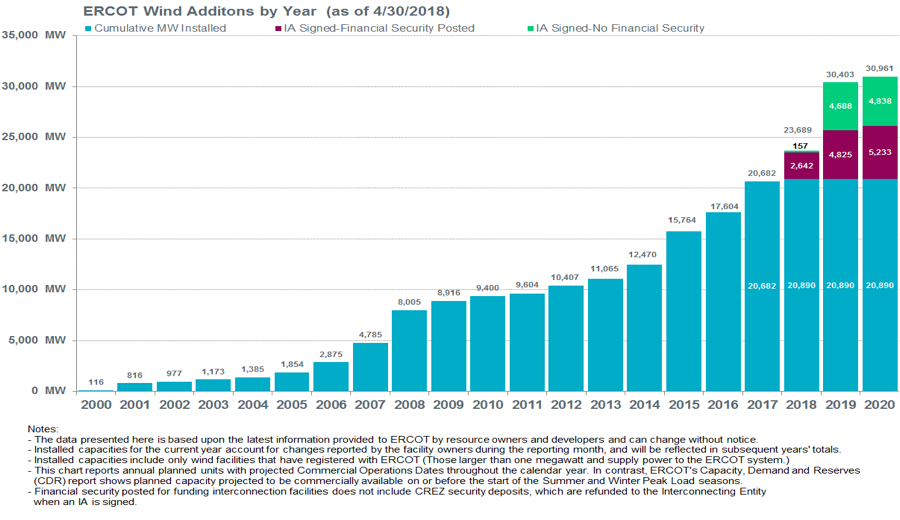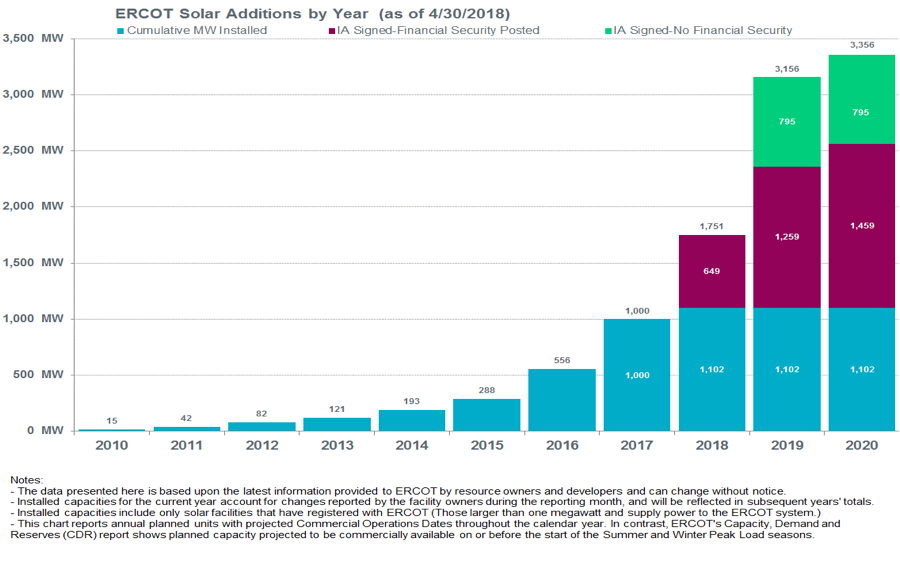By Cyrus Reed, Conservation Director
Last year, Luminant, a subsidiary of Vistra Energy, announced it planned to retire more than 4,000 megawatts (MW) of old coal-fired power plants in 2018. This decision was primarily the result of our electric market working as it should -- old, inefficient, dirty power plants going offline, as newer, more affordable, clean solar and wind power continued to add capacity to our grid.
The question on the minds of electric grid watchers now is, will there be enough power to keep the lights on this summer?
Earlier this month, at a packed Senate Committee on Business and Commerce at the Texas Capitol, officials from our electric grid operator, ERCOT (Electric Reliability Council of Texas) said they had the tools they need to keep our grid healthy and stable, that new sources of power were coming online, and some very old power plants had come out of “mothball” status in hopes of earning some money (think of high school economics class - as supply of electricity becomes more scarce due to higher demand, the price increases, so not-so-cost-effective power plants are more likely to re-enter the market). To bolster their case, they released two reports - the “SARA” and the “CDR” (see below) -- that indicated there would be approximately 11 percent reserves if temperatures are as expected this summer - hot but not too hot. That reserve margin means that, at peak power consumption, there would still be 11 percent more generating capacity available, providing a cushion against blackouts given unprecedented demand or system failures.
Who Is SARA And CDR And What Did It (She) Say?
The Seasonal Assessment of Resource Adequacy (SARA) is a report put out by ERCOT four times a year that assesses expected conditions for the next season, while the Capacity, Demand and Reserves (CDR) report is put out twice a year, and gives a longer-term (five years) look at current and future resources, future demand and potential retirements.
According to the SARA, ERCOT expects to have sufficient generation to meet customer demand this summer. The final summer SARA report includes a 72,756 MW summer peak load forecast based on normal weather conditions. This forecast is more than 1,600 MW higher than the all-time peak demand record set in August 2016.
The planning reserve margin for summer 2018 has increased to 11 percent based on the resource updates incorporated in the final summer SARA report. The CDR shows reserves through 2022 in the range of 10.9% to 12.3%. While these reserves are lower than the 12.5 to 13.75% of reserves that ERCOT in general has traditionally considered the preferred target, and much lower than recent forecasts, more recent studies have concluded that an “Economically Optimal Reserve Margin” can actually be in the 10-12 percent range.
Expected resources include existing “traditional” generators (nuclear, coal and gas plants) plus utility-scale wind and solar resources in addition to new resources, primarily natural gas, wind, and solar, projected to come online. Also making a return for the summer season are two older natural gas units owned by Garland Power and Light (built in the 1960s) and the mothballed coal plant Gibbons Creek, owned by Denton, Greenville, Garland, and Bryan. Both are expected only to operate this summer and then once again go into mothball status.
It is important to note that the SARA report does include some more extreme scenarios. In the worst-case scenario, using 2011 weather patterns (remember how awfully hot that summer was?), demand would increase by more than 3,000 MW on a hot summer day. If some gas and coal units were unable to operate, then SARA predicts there could be some periods where ERCOT would utilize all of its reserve capacity plus a service known as Emergency Reserve Service - essentially paying some large customers to stop using electricity from the grid. Even then, some brown-outs might be possible.
What Is Our Public Utility Commission Doing About It?
The Public Utility Commission -- which currently only has two commissioners serving because Commissioner Brandi Martinez recently resigned -- has been meeting with stakeholders, and enacting small changes designed to ensure maximum power is available this summer. First, the PUC has suggested that generators be available all summer and asked generators to do their maintenance work before June 1. Similarly, PUC has worked with ERCOT and transmission companies to make sure that major transmission projects or maintenance are not done between June and September to ensure that transmission lines are energized and not overly congested. Furthermore, earlier this year, the PUC ordered ERCOT to make tweaks to a “price-adder” which is applied in general in times of scarcity which should give an incentive for more investment in both generation and demand response to respond to higher prices.
What About Renewable Energy?
Clean energy resources continue to increase. According to the latest “GIS Report” --- the Generator Interconnection Status Report published each month by ERCOT -- renewable energy development continues to look breezy and bright, with wind expected to reach 30,403 MW by the end of 2019 and solar expected to equal 3,156 MW by that date (see figures). These investments are being spurred both by continued investment from cities, like the recent decision in Denton to add 100 MW of solar to its energy mix, and corporations like Apple, Google, and Facebook also making clean energy investments in Texas.


However, there continue to be issues with some very congested lines in West and South Texas. Many wind generators are being forced to hold back power at certain hours of the day due to congestion. Indeed, wind developers are waiting for ERCOT to complete studies that might allow the grid operator to relax some parameters, allowing more wind power onto transmission lines in the Panhandle.
ERCOT and its stakeholders also continue to assess the need for more ancillary services (basically paying for reserves) to ensure continued grid reliability. One particular area of interest is making sure there is sufficient “inertia” on the system, normally provided by spinning machines like gas turbines.
Solutions?
The Sierra Club believes the ERCOT market is working well and that major overhauls are not needed. However, small but important reforms are needed to keep up with technological innovations that will modernize the grid and incorporate more cleaner energy options. Over the coming weeks we will be looking more in-depth at solutions to increase resources and decrease demand, including:
Bolstering our required energy efficiency programs
Making changes to our market to allow distributed technologies like solar, energy storage, and energy efficiency to participate more directly in the market
Allowing better access for customers to “smart meter” information
Allowing “non-wires” alternatives to transmission like energy storage and demand response to provide services
Reforming our ancillary services to provide more opportunity for alternative technologies to bolster our operating reserves
ERCOT’s market is working well, and we believe that older dirtier plants will continue to retire even as we add new technologies if we just allow the market to work.